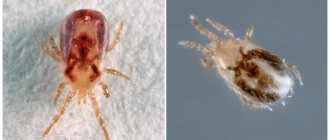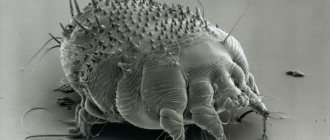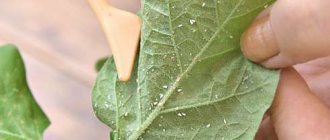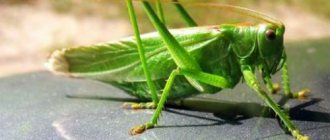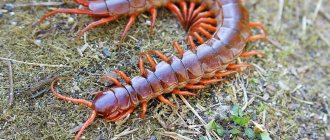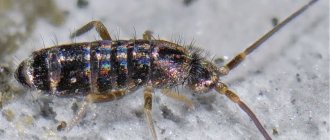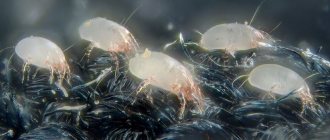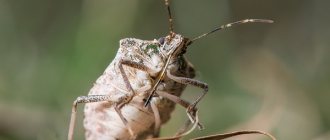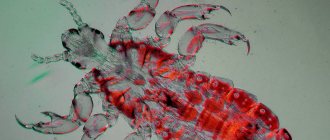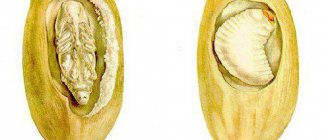Description of the parasite, causes of appearance
Ticks belong to the family of small arachnids.
They are divided into two orders: acariformes and parasitiforms. Acariform mites are closer to phalangeal arachnids, while parasitiform mites belong to the class of harvesters. The feather mite (photo presented in the article) belongs to the order Acariformes. The parasite is almost impossible to detect; it has a transparent scaly body, and its dimensions do not exceed 0.5 mm in length. Due to the peculiarities of its structure, it cannot bite a person, however, the protein that it secretes in the process of life can cause an acute allergic reaction.
The main reasons for the appearance of the insect are unsanitary conditions and careless attitude towards personal and bedding. Ticks spread very quickly. It is impossible to completely get rid of them, but you can significantly reduce their numbers.
Habitat
The pests live and breed on birds' feathers, causing them to fall out over time. In residential buildings, feather mites are most often found in pillows (photo below), upholstered furniture, carpeting and places where dust accumulates. However, down and feather pillows are considered the most favorable habitat for the parasite.
Feather base and human sweat combine to create the optimal temperature and humidity necessary for insect reproduction. Most people ventilate the room before going to bed, thereby improving the living conditions of the insect, since fresh air is one of the main components of its life support.
If not properly cared for, any down or feather product will gain weight after a few years due to the accumulation of dust and mites. On average, there are up to 200 individuals for every centimeter of feather pillow. As a rule, parasites get onto human skin from down or feather products, causing clearly noticeable discomfort.
Since it is extremely difficult to completely get rid of feather mites, down and feather filling of bedding is prohibited in most developed countries. This mainly concerns municipal children's institutions, hospitals, sanatoriums, hotels, barracks and student dormitories.
Modern manufacturers give preference to synthetic fillers such as padding polyester and holofiber. It is much easier to care for such products; in addition, the existence of parasites in them is almost impossible. For people who prefer natural materials, bedding with bamboo or coconut fiber, buckwheat, pine needles and even purified meadow hay is recommended. It is advisable to update pillows once a year.
Danger to humans
If treatment is not started in time, feather mites can cause acute allergic reactions or aggravate existing diseases:
- Asthma. The patient experiences attacks of the disease more often.
- Allergies are possible with a severe cough, watery eyes and runny nose. If you eliminate the allergen, you feel better and the symptoms disappear.
- Hives are accompanied by itching, and characteristic pink spots appear on the body.
- Atopic dermatitis - manifested by redness and peeling of some areas of the skin, severe itching is possible. The disease requires long-term treatment.
- Swelling of the airways is the most dangerous possible reaction, as it can be fatal.
Description, causes of infection
These parasites belong to the arachnids, have very small body sizes, which greatly complicates their detection; they grow up to a maximum of 0.5 mm. In addition, their body has a very light color and is almost transparent. These ticks, unlike other species, do not feed on the blood of animals and people; their body structure is developed completely differently and is adapted for biting, so in this regard they are absolutely harmless. But the danger is still present, since in the process of life they secrete a protein that can cause quite acute allergic reactions in humans. You can see what feather mites look like in the photo.
The main and main reason why these parasites appear is unsanitary conditions. The threat is that they multiply very quickly and after a short period of time huge colonies appear. It will not be possible to destroy them completely, but it is possible to reduce their numbers to a minimum. They are often called bed, pillow, household, dust, and all because of their habitat.
If we talk about their natural habitat, they parasitize birds, namely their feathers. In apartments and houses, they choose upholstered furniture, carpets, mattresses and other textiles for living. They choose hard-to-reach places where dust accumulates. But most often they live precisely in pillows and feather beds, in which they find the most favorable conditions.
What are feather mites?
Feather mites can feel comfortable not only in blankets and pillows, but also in other products consisting of down or feathers. The tick lives for about 80 days, and leaves behind a clutch of eggs, the number of which reaches 60-70 pieces. They live in entire colonies. One gram of dust can contain from 10 to 10,000 individuals. The norm is the presence of up to 100 parasites in 1 g of dust, since this concentration of insects is quite safe for humans.
Dust (feather) mites are synanthropic organisms.
They always live next to a person. Ideal conditions have been created here: fairly warm, moderate humidity, plenty of food. Mites often feed on woolen lint in bedding. However, the main source of food is dead human skin cells, of which there are about one and a half grams daily.
Types of house ticks
House ticks are dangerous parasites that harm household items, products and even human health. They are invisible to the human eye and are found in any living space. More than 160 species of ticks can live in symbiosis with humans. The most popular of them:
- Itchy. It parasitizes only the human epidermis. Develops in a warm, humid environment. Causes a disease - scabies.
- Hairy. Found in foods. Optimal development conditions are an ambient temperature of about +25 degrees. Can cause inflammatory skin lesions in humans.
- Chicken. Distributed in chicken habitats and excrement. It can also parasitize human skin, causing irritation and itching.
- Rat. It lives mainly on the epidermis of rodents, but with a lack of nutrition, it can migrate to humans. Mainly lives in rural areas.
- Dusty. It feeds on dead epidermal cells, fungi, and bacteria. They do not bite, but they do cause damage with their excrement. In small acceptable quantities they do not harm humans, but when the population increases they can cause allergic reactions.
All types of parasitic insects can cause severe diseases of the skin and respiratory tract.
What does a feather mite look like? Photo under a microscope
Few people know that feather mites are individuals belonging to the group of pests Dermatophagoides (dust parasites). They are characterized by a body length of 0.1 to 0.5 mm. This allows them to remain undetected for a long time. Moreover, in a dream, when a person’s head is on the pillow, there are no external sensations. Even the appearance of a large number of pests does not cause discomfort during rest.
If you are wondering what ticks look like in pillows, you need to consider that they move using 4 pairs of limbs. Moreover, there are suction cups and claw-like protrusions on the legs. This allows pests to stay on the fluff of the fluff. The body of parasites is oval, convex.
These mites have powerful mouthparts
(consisting of claw-shaped chelicerae), thanks to this, pests chew through particles of dead epidermis.
Feather mite under a microscope. Feather mites have powerful mouthparts Photo of a feather mite under a microscope
Symptoms of subcutaneous mites
Allergy sufferers suffer the most from the pest. The most severe allergic reactions include:
- redness and rash, in some cases throughout the body;
- scratching in places of unbearable itching;
- lacrimation, conjunctivitis.
Other symptoms of demodicosis:
- rash, purulent inflammation, acne;
- sallow complexion;
- enlarged pores;
- itching in the ear area;
- increased hair loss;
- weakened immune system;
- increased work of the sebaceous glands;
- attacks of itching at night.
Most often, ticks can be found on the wings of the nose, around the eyes, on the eyebrows and eyelashes. In the latter case, the eyelashes become thin and fall out. Parasites are extremely rare on the body
To prevent complications of the disease, it is important to consult a specialist in time and undergo a course of treatment.
With demodicosis, the most pronounced symptoms are:
- itching, which is most noticeable at night;
- rash, pustules;
- skin redness;
- enlarged pores;
- gray complexion;
- hair loss in the second stage;
- itching of the ears.
In most cases, demodex mites manifest themselves during hormonal imbalances, severe stress, and decreased immunity. It also occurs in teenagers and pregnant women.
Stages of development
The disease is divided into two stages:
- Demodex mites are located on the surface of the skin, causing peeling and small accumulations of rash in certain places on the face, these are the areas around the nose, nasolabial area, eyebrows and eyelashes.
- At the second stage, the back, chest, neck, hips, and arms may be subject to demodicosis.
The mite primarily affects areas of the skin with the greatest accumulation of fat. First, tubercles form, then pus comes out of the pimple and the mite moves to a neighboring unaffected area. It is impossible to detect parasites in yourself; they can only be seen under a microscope.
At the clinic, a specialist prescribes examinations of the liver, gastrointestinal tract, thyroid gland and gynecology for women. Demodicosis can be caused by gastritis, stagnation of bile in the gallbladder, and chronic cholecystitis.
Additionally, you need to take a blood test.
Harm from mites in bedding
Without examining bedding using a microscope, it will not be possible to identify unwanted neighbors - their sizes are so small that they are not visible to the naked eye.
Colonies of microscopic insects, fungi and bacteria inhabit any dusty corners of the apartment, actively growing on bed linen, in the thickness of pillows and mattresses, in the pile of the carpet and soft toys.
It is almost impossible to get rid of them once and for all, but this is not a reason to completely ignore the problem. Acarids cannot cause direct harm to humans, because they do not feed on blood through bites, but on exfoliated skin flakes, particles of sweat, dandruff, and sebum. But their excrement poses a serious threat.
The size of an adult varies from 0.1 to 0.5 mm, and its waste products are even smaller. During the digestion process, ticks have to produce large amounts of enzymes that break down the human epidermis.
Practice shows that people who love space, who toss and turn in their sleep and who have respectable dimensions are satisfied with the size of a single bed.
Almost every car bed model has a trunk box, which is suitable for storing bed linen and pillows. There are voluminous crib bodies that replicate the silhouettes of real cars, with spinning wheels made of soft plastic. Details here.
Fecal pellets left by insects contain these components in high concentrations. They are the main threat to the human body.
Getting on the mucous membranes when breathing, settling on the skin, attacking the eyes and polluting the lungs, the active substances cause serious disturbances in the respiratory system, irritate the skin, and can cause impairment of vision and smell.
The most common diseases and symptoms, the invisible cause of which are mites in pillows:
- allergies accompanied by rhinitis, conjunctivitis and asthma attacks;
- atopic dermatitis;
- swelling of the respiratory tract, trophoneurotic edema or urticaria (Quincke's edema);
- up to 70% of diagnosed cases of bronchial asthma.
With a reduced immune barrier, they can cause skin irritations, acne and deep infections - other mites (for example, demodex) that parasitize directly in the human body can penetrate into microdamages in the skin formed under the action of enzymes.
Remedies and methods for getting rid of bed mites
None of the existing methods guarantees the complete elimination of the feather mite population, but by taking the necessary measures, it is quite possible to reduce its population to a safe level. Under such conditions, you can be sure that parasites will not cause allergies.
How to get rid of bed dust mites? There are several types of means with which you can control their vital activity.
Chemicals, preparations and suspensions, the composition of which makes it possible to exterminate ticks. At the same time, they are completely safe for humans, for example:
- Allergoff spray , which not only has a detrimental effect on pests, but also neutralizes their waste products containing allergens;
- Easy Air is an organic product in the form of a spray. Suitable for processing various surfaces. Helps eliminate allergy symptoms caused by parasites;
- Milbiol aerosol is a bed mite treatment intended for treating mattresses and textile surfaces. The active substances of the drug act directly on ticks, disrupting their ability to feed and stopping their development and growth;
- Dani Earth is a spray from a Japanese manufacturer. Suitable for cleaning upholstered furniture, toys, pillows. It has a non-sticky texture, so it dries quickly;
- Digital . The preparation for treating premises is highly concentrated and toxic, so it should be used only in diluted form and only in personal protective equipment;
- All-Rug . This is a shampoo for cleaning carpets and washing floors, preventing the development of domestic parasites.
It is possible to independently prepare a product for treating places where a lot of dust and things accumulate. To do this, you need to prepare a saline solution, observing the following proportions: liter of water per 200g. salt. This composition will help fight household ticks.
If ticks appear in the house, then, in addition to treating the premises with chemicals, it is important to regularly ventilate and carry out wet cleaning. If there are allergy sufferers in the family, it is advisable to purchase a vacuum cleaner with an aqua filter: a regular vacuum cleaner not only does not neutralize allergens, but also contributes to the spraying of mite particles and their excrement. A household steamer can destroy dust mites by exposing them to hot steam. Make it a habit to steam the mattress, blanket and pillow on both sides when changing a set of bed linen, this will prevent the appearance of parasites. After this procedure, the laundry needs to be thoroughly dried.
The danger of a linen mite bite
Dust mites in pillows find themselves in greenhouse, extremely favorable conditions. Thanks to human sweat and the hygroscopicity of the materials used for bedding, an optimal humidity level is maintained inside.
The constant warm atmosphere of the bedroom is just as pleasant for microinsects as it is for people. And periodic drafts and ventilation only add comfort - they really love the flow of fresh air.
The colony multiplies very quickly, and there is more and more waste. Any mattress or feather product without proper care can double its weight in 5 years - that’s how much dirt, microorganisms and fungi accumulate there.
So it turns out that instead of proper rest, a person each time receives an increased dose of toxic allergens, inhaling them throughout the night. Moreover, symptoms and discomfort may appear 10–20 minutes after the start of contact with the bed.
And by the morning the result is manifested in all its glory - redness of the eyes, swelling of the face and mucous membranes, difficulty breathing, headache and scratching on the skin.
Hygiene standards in many countries do not allow the use of feather and down bedding. Such rules apply especially harshly to children's institutions, hospitals, hotels, hostels and other similar institutions.
The reason for the ban is the impossibility of complete and irreversible destruction of parasitic colonies of bed mites inside the product.
When purchasing bedding, it is better to give preference to fillers such as silicone, holofiber, padding polyester, and other synthetic materials. They are less susceptible to colonization by microorganisms, and caring for them is not so labor-intensive. From natural materials, you can choose bamboo or coconut fibers, buckwheat husks, and hop cones. As a summer cottage option, meadow hay is quite suitable - it is only important to ensure that no poisonous herbs or plants that cause allergic reactions are included in the collection (see Which filling is best for pillows).
It is advisable to change any pillows after six months (maximum a year) of regular use, especially for those stuffed with natural materials. This measure will most effectively protect against problems caused by proximity to ticks.
If this is not possible, then you can at least try to reduce the number of parasite colonies and get rid of their waste products.
Danger of House Dust Mites
Small particles of Dermatophagoides mites and their feces are strong allergens. The excrement contains the proteins Der f1 and Der p1. They have a particularly detrimental effect on children living in urban areas. In rural areas, where a child comes into contact with animals and various microorganisms, he develops a strong immune system. Urban children are more susceptible to diseases; in 70% of cases of bronchial asthma, the source of the problem was an allergy to dust mites. Particles and secretions of arachnids enter the human body through the respiratory tract. Contact with them causes immune reactions on the skin. In areas of irritation, arthropod protein easily penetrates the skin, aggravating the problem.
Symptoms of an allergy to mites in pillows:
- sneezing and a feeling of nasal congestion without a cold;
- obsessive, incessant cough;
- loss of appetite;
- shortness of breath and difficulty breathing during exercise;
- swelling of the eyelids, itching;
- red rashes on the face.
When performing diagnostics, the presence of an allergen to house dust mites is detected. In addition to an allergic reaction, they cause other serious illnesses:
- conjunctivitis;
- atopic dermatitis;
- bronchial asthma;
- allergic rhinitis.
Information. In many countries, feather and down filled pillows are prohibited for use in hotels, childcare centers and hospitals.
How to deal with ticks in bed
Everyone knows that hygiene is the key to health. This rule turns out to be effective in any situation, and the problem with bed parasites is also partially solved by observing sanitary standards.
Frequent washing and obligatory ironing of pillowcases with a hot iron will help get rid of unwanted “tenants” on the surface. But deep cleaning will require more significant effort.
In hospitals or hotels, bedding should be processed in autoclaves - exposure to high temperature and pressure effectively destroys not only adult ticks, but also tick eggs.
Unfortunately, this approach greatly spoils the appearance of the products and requires special equipment, so it is not applicable at home. And public institutions often neglect the rules, so on a business trip or on vacation it is safer to purchase a small personal pillow than to use the one provided by the hotel.
As a last resort, you can sleep on an inflatable pillow - its surface is easy to clean and disinfect, so insects have no chance.
Feather mites in pillows can be destroyed by taking them outside at least once a month - the sun or frost will do the job perfectly. It is important to take into account that such temperature treatment cannot be short; 1 hour will not play a significant role.
A product with down or feather filling should be frozen for 24 hours, periodically shaking and fluffing (see Cleaning feather pillows). The sun's rays and a temperature of 40 degrees act slower than frost; you will have to fry for 2-3 days. The advantage of such procedures is that in 2–3 hours, under the influence of ultraviolet light, allergens are decomposed and neutralized.
A significant disadvantage is that sunbathing and street ventilation will only bring a temporary effect, since the adult individuals will die, but the eggs, which are very resistant to changes in external factors, will survive.
To reduce the contamination of the bedroom, it is necessary to carry out regular wet cleaning, dust in all accessible places, wash the floors and wipe the furniture with a strong saline solution (200 g of salt per bucket of water).
Any bedding, mattress covers, as well as fleecy bedspreads, blankets, pajamas, housecoats should be washed and shaken out as often as possible, and it is best to dry them in the sun - this will remove most of the acarids and their metabolic products.
Standard euro size of a single bed: length 200-210 cm, width 90-100 cm. All necessary accessories in European countries are produced in accordance with these measurements.
Removable bumpers for children's beds are very convenient because they can be removed at any time, and then the bed will return to its original appearance. Read a description of the types and designs of protective sides here.
For greater washing efficiency, you can use various acaricidal substances and additives. Easy to use sprays for upholstered furniture and fabric surfaces, additives to washing powder that neutralize mites and allergens produced by them.
As a rule, products with synthetic padding are easy to wash and dry quickly, so they are safer than feather and down ones.
How to get rid of ticks in pillows
It is impossible to completely exterminate all ticks, but you can try to reduce their population. The oldest and most proven method is called temperature exposure.
Pillows and blankets can be taken out into the cold in winter or warmed up in direct sunlight in summer. The period of such exposure should be long, preferably several days in a row.
Effective drugs
Mites on bedding can be easily eliminated by washing and carefully ironing. You can treat furniture and pillows with a steam cleaner, but the downside is that steam only kills adults and does not affect eggs and larvae.
Today there are many special acaricidal drugs that can cope with large numbers of ticks.
Akaril is available in liquid or powder form for cleaning carpets and washing bed linen. It can also be used to treat upholstered furniture and mattresses, but first dissolve it in water. According to users, the product is not bad, but it cannot clean the filling of pillows and feather beds. The advantage is that the product has a completely natural composition.
The cost of a 240 ml bottle is 2,700 rubles, and it is enough for 12 washes.
Allergorr is an excellent Polish spray to combat dust and feather mites. It is enough to spray it over the entire surface of the apartment, on pillows and bedding. The duration of the drug is up to 7 months.
According to reviews, Allergorr is considered one of the most effective products, without an unpleasant odor, and does not cause allergies when used. The price of a bottle (400 ml) is 1300-1700 rubles.
Another spray from the same series is the Swiss drug Milbiol. Users have only positive reviews of it, because it is enough to spray it on carpets, furniture, pillows and blankets. The product has a pleasant smell and does not cause allergic reactions. For a bottle of spray (250 ml) you need to pay only 130-150 rubles.
Folk recipes
In addition to chemical sprays, folk remedies are also used to combat ticks. They are safer, non-toxic, and do not harm pets or people. Although, acaricidal drugs are much more effective than traditional recipes.
You can prepare a lotion from water and tea tree oil, with the addition of a couple of drops of Eleutherococcus tincture. Before going to bed, apply the lotion to the skin of the face and neck, wipe the body.
This will repel parasites and make the bed safe.
Some housewives advise treating furniture and pillows with regular saline solution. The most modern way to get rid of feather mites is a vacuum cleaner with a HEPA filter.
It not only collects all the smallest particles of dust, but also destroys microscopic mites.
How to get rid of dust mites
To make sure that the room is contaminated, the dust should be submitted for examination. However, the main methods of dealing with ticks are aimed at maintaining cleanliness in the house. Therefore, they can be used regardless of the results of the check or without it at all.
Wet cleaning. Parasites feed not only on fur and skin, but also on various debris. Therefore, you need to try to keep it as small as possible. Remove the food source; this will not completely eliminate the parasites, but will significantly reduce their population. It is necessary to regularly carry out wet cleaning even in hard-to-reach places. It is extremely undesirable to wipe off dust with a dry cloth or broom, because allergy-causing substances will spread throughout the home.
Use a vacuum cleaner. It is an excellent way to remove dust and insect waste products. Here it is better to use vacuum cleaners equipped with filters. They will trap allergens, preventing them from spreading throughout the apartment. Soft parts of furniture also need to be vacuumed. To do this, you should use special attachments.
Wash. All bedding is a potential hazard area. They must be washed as often as possible using hot water. Its temperature must be at least 60 degrees Celsius. This will destroy existing insects. In addition to bed linen, soft toys, curtains and drapes should be washed frequently.
Freezing. Not all items can be soaked, so you can use freezing. In winter, this will not be a problem, but in summer, each item should be packaged separately and then placed in the freezer. To get a good effect, items must be in the cold for at least a day.
Humidity. Dust mites love high humidity. To make their life less comfortable, try to lower it. To do this, just use a dehumidifier. In summer you can open the windows. After taking a shower, it is recommended to turn on the ventilation; do not forget about the hood when preparing food. Buy a hygrometer that will allow you to always monitor the humidity level. It should not exceed 50 percent.
Temperature. A temperature of 25-30 degrees is considered comfortable for dust mites. Therefore, it is advisable to maintain a room temperature of 21-23 degrees. Do not forget about high-quality ventilation.
Disinfectants can be used not only when an apartment is infected, but also for preventive purposes. After cleaning, it is enough to use a special spray in places where dust often accumulates: baseboards, corners, shelves, curtains, around furniture. Lysol or other similar drugs are suitable for these purposes.
Aromatic products . Many essential oils have a strong odor and help fight pests. For example, eucalyptus oil can be added to the water in which clothes are washed, mixed with water and sprayed onto furniture.
Get rid of clutter. Go through old things: books, accessories, jewelry, picture frames, decorative pillows. Of course, it is impossible for there to be no dust at all in the house, but you can reduce the amount of dust. You just need to throw away old things.
Animal cleaning. Pet fur is another source of dust insects. Try to keep it in the house as little as possible. Brush your pet's fur regularly. This should be done outside, using a brush.
Which pillows don't harbor ticks?
Today there are many bedding fillings that are not suitable for parasites. The so-called bio-pillows deserve special attention. Buckwheat husk is used as a filler here. They are sealed, so dust and dead skin do not get into them. Thus, there is no food for ticks, and they cannot get inside.
( Video : “With mites in bed: why should you get rid of your feather pillow?”)
Bamboo products are also popular. Deodorizing, antistatic and bactericidal are the natural properties of bamboo. It contains a natural antiseptic.
If it is not possible to purchase such products, it is recommended to use covers for bedding. It is desirable that they be made of hypoallergenic materials. Plastic products are also suitable. Parasites do not live on such covers. And their perfect tightness protects bedding from penetration.
Which pillows do ticks not live in?
Fortunately, nowadays there are many other fillings for blankets, mattresses and pillows that are completely unsuitable for dust mites. The website "Who's Over 30" will tell you about the best of them.
Bio-pillows filled with buckwheat husks
This type of filler is very hygienic; it does not become clogged with dust or parasites.
Such bedding is absolutely not inhabited by insects; dust mites do not live in pillows filled with buckwheat husks, since there is no food for them.
In addition, such bedding is hypoallergenic and has an orthopedic effect.
Hypoallergenic pillows
These are accessories for sleeping and relaxation that are made from 100% natural materials - allergen-repellent wool and 100% cotton.
Such pillows are absolutely airtight, due to which neither dust nor parasites can get into their middle. The service life of such products is up to 10 years!
Caring for them is quite simple - you just need to change the pillowcases every two weeks, wash in lukewarm water, without using aggressive detergents, bleaches or conditioners.
Bamboo pillows
The fiber of this plant has unique natural properties, namely, bactericidal, antistatic, and deodorizing.
Dust mites do not live in such pillows. Bamboo fibers contain a natural antiseptic that prevents bacteria and parasites from multiplying.
About 70% of bacteria that land on a pillow die. It should be noted that over time, the antibacterial properties of bamboo pillows do not weaken, remaining even after numerous washes.
Control measures
The most radical methods of removing dust mites from pillows ensure their rapid destruction literally within a few hours.
These methods include:
- Treating pillows with products based on acaricides - substances that can quickly kill ticks. These include drugs based on organophosphorus compounds, pyrethroids, neonicotinoids and some other substances. When using them, it is necessary to ensure that the filler itself is treated with the preparation, and not just the pillow cover;
- Freezing pillows in the cold. Although mites die in a few hours at sub-zero temperatures, the pillows should be kept in the cold for at least 2 days to ensure that the eggs freeze out;
- Warming up the pillows in the sun for several hours, raising their temperature to 60-65°C, or washing at a water temperature of 60°C.
More conservative methods involve long-term removal of mites, but with less risk to the pillow material.
In particular, it is advisable:
- Use pillowcases made of fabric that does not allow allergens and dust to pass through (permeability for allergens - less than 1%, for dust - less than 4%, pore diameter - no more than 10 microns, air permeability - 2-6 cm3/(sec*cm2));
- Have two sets of pillows, on each of which people sleep for no more than 2-3 months in a row.
These measures are good because they do not require much effort and give quick results. In particular, allergens already in the pillow do not come out and do not enter the human respiratory tract - they are retained by the pillowcase. This same pillowcase prevents skin and dandruff from penetrating the pillow, and over time, the mites inside it are deprived of their food source. If no one sleeps on the pillows during their rotation for 2-3 months, the ticks are left without food and die out over time.
Very old and heavily infected pillows, which are also likely to have mold, should be replaced with new ones and thrown away.
Considering that dust mites can live not only in pillows, but also in almost any other place in the room, when exterminating them, you cannot limit yourself to just the bed. It is necessary to take measures to destroy them anywhere in the apartment where dust accumulates.
On a note
When fighting dust mites, it is useful to use special sprays that decompose mite allergens and make them safe for humans. The fact is that even after the ticks are completely destroyed, their feces can remain in the smallest crevices for many months, continuing to cause allergies. If the room is treated with special degradant sprays, then the allergens will no longer pose a danger.
How to clean your bed from harmful microorganisms
It is not possible to get rid of ticks completely and forever; the main rule is to keep the house clean and carefully care for bedding.
What will help get rid of dust microorganisms in pillows:
- Ideally, replace down and feather products with accessories with synthetic filling: padding polyester, holofiber, comforter, which must be washed once every six months at temperatures above 50 °C.
- If you don’t want to part with natural materials, or for children, you can choose an alternative with the following fillings: buckwheat husk, bamboo or coconut fiber, latex.
The hypoallergenic properties of buckwheat and the antibacterial properties of bamboo make these materials optimal for children's bedding.
Fans of fluff and feathers can bring out “guests” in several ways:
- Airing the pillows in the air for at least 5–6 hours gives a temporary effect. In winter - in frost, in summer - in direct sunlight. This method does not work for long, since tick eggs are insensitive to heat and cold, only adult individuals die.
- Once a year it is worth disinfecting such products with special dry cleaning products.
- You can also clean the pillow yourself. The bedstead needs to be washed, ironed (or replaced). Down filling - treat with a soap solution (100 g of laundry soap + 100 g of ammonia per 10 liters of water), rinse thoroughly and dry, then put the product back together.
Attention! Regardless of the material of manufacture, it is recommended to change all sleeping accessories every 5–6 years.
It is worth noting that it is impossible to get rid of dust mites by cleaning only the bed linen. Additionally, you need to weaken the provoking factor:
- sort out deposits of soft toys;
- reduce the number of carpets and curtains;
- Follow the rules for storing winter clothes.
What causes mites to appear in bed?
Why is the bed most often attacked by dust mites? How do they get here?
The fact is that in every home, despite diligently maintaining cleanliness, there is a small population of these parasites. With frequent cleaning, washing and cleanliness of linen, replacing the filling in feather pillows with a more modern one, the number of mites is kept within the acceptable range: they are not enough to become a source of allergies.
If wet cleaning of premises and changing of bed linen is carried out rarely, a large number of keratinized skin particles accumulate in the layer of dust and on the fabric of bedding, on which clothes mites feed. Thus, favorable conditions are created for their nutrition, development and reproduction.
You should be especially careful: bed mites are often observed in rented apartments and rooms in inexpensive hotels, where guests often change and bed linen is not properly processed.
Replacement of down and feather
The times when down pillows were considered the best are in the past. Today there are many fillers in which parasites do not like to settle.
Herbal options include:
- buckwheat husk – elastic, hypoallergenic, with a pleasant aroma;
- bamboo fiber – antibacterial, elastic, breathable;
- latex is elastic, easy to clean, eliminates the appearance of mites and other microorganisms.
Synthetic polyester fillers allow for more frequent hygienic treatment:
- holofiber – non-woven material;
- comfort - elastic polyester balls;
- Sintepon is an inexpensive material, but quickly loses its shape.
When choosing a filler, consider the age and individual needs of the person. For children, it is better to choose natural fibers that do not cause allergies. Ticks that live in pillows do not grow in buckwheat and bamboo.
Can lice live in a pillow?
A louse is a parasitic creature, which means it cannot exist outside the host for a long time (several days), since it feeds on blood. An adult lives for 38 days, managing to lay several hundred eggs. The bites of these insects are painful and itchy, as saliva is simultaneously injected, which prevents blood clotting, which is accompanied by unbearable itching.
A human lice inside a pillow will not survive without food, but it can be found on bedding. But we are not talking about a colony of lice, their vital activity and the laying of nits, but about a short-term stay. If the individual does not return to its owner within 24 hours, it will die.
Linen lice can live in the folds of clothes that are worn for several days in a row, form colonies in secluded seams, lay nits, but also need forays for food.
Important! Lice reproduce only at a temperature range of 22–40 C, and die at 44 ° C. It is recommended to wash bed and underwear at a temperature of 50 °C and iron them.
Do bedbugs live in pillows?
Bedbugs are blood-sucking insects that prefer a warm, draft-free atmosphere. Their bites are painful and can leave marks (droplets of blood) on pillowcases, which help to understand what kind of living creature shares the bed with the owner.
Pillows are not the most favorite habitat of bedbugs; they prefer cozy seams and folds of furniture upholstery or stationary mattresses. These are the places that should be checked first if there is a suspicion of a blood-sucking neighborhood.
Bedbugs avoid pillows for several reasons:
- the large size (4–8.6 mm) does not allow insects to freely penetrate through the thick fabric of the bedspread;
- bedding is often turned over, shaken, etc.;
- Any filler is distributed unevenly inside, making it difficult for bedbugs to move.
USEFUL INFORMATION: How to wash a blanket: camel wool, down, cotton, padding polyester and others
You can get rid of parasites in pillows as follows:
- natural products should be taken to dry cleaning or disposed of;
- synthetic - wash at a temperature of 50 ° C, then dry in the open air.
Bed bugs get into pillows when their population becomes too large and their “favorite” places - sofas and mattresses - are occupied. In this case, you cannot do without general sanitation of the room.
It will not be possible to completely get rid of pests in an apartment, but it is possible and necessary to reduce their numbers by following simple rules, which will help you spend the night hours with pleasure and health benefits.
How to fight correctly
Of course, when parasites have reached enormous numbers, it will be quite difficult to get rid of them without the use of specialized means. Nowadays there is a huge assortment on the market that allows you to quickly and effectively treat a room and get rid of all types of parasites.
If we talk about the most popular ones, they include the following drugs:
- Digital. Shows good results when treating residential premises. It can be purchased in powder form, which is diluted with water in portions according to the instructions and the solution is treated with the surface.
- Sipaz. Released specifically for residential premises, the advantage is safety for people and animals. It has a prolonged effect, after treatment the effect lasts up to 1.5 months.
- Easy air. This product contains only plant components that have a detrimental effect on ticks.
- Available in the form of a spray that can be used to treat upholstered furniture, carpets, and mattresses.
In addition, there are a large number of sprays containing natural herbal ingredients that are suitable for treating bedding.
Remember that the use of any product must be carried out strictly according to the instructions, and be sure to follow safety precautions. In most cases, when treating a room, you need to leave the apartment for a day and upon return carry out a thorough wet cleaning. When processing bedding, they must be washed.
After sanitization, it is advisable to leave the premises for a day. Then carry out a thorough cleaning using chlorinated products. Wash and steam bedding.
Pillows must be dry cleaned; by the way, this procedure is mandatory and must be done once a year. Dry cleaning uses different cleaning methods, so always check this point.
In the event that it is not possible to dry clean it, you can do it yourself:
We take a large container and in it prepare a solution of laundry soap and water. Next you will need a bag or a large piece of fabric into which we transfer the contents of the pillow
It is important that the feathers are well separated; they should not be pressed or compacted. We tie the bag and lower it into the previously prepared solution. Feathers must remain in the solution for at least 4 hours. Every half hour, you will need to knead the contents of the bag and also shake the soap solution. Then rinse well in water, preferably running water. Hang it outside.
Caring for feather pillows
You don't have to give up your favorite feather pillows because of mites. They need to be looked after properly. In addition to seasonal drying and freezing, feather washing is recommended. Once every 2 years, pillows are taken to dry cleaning, where appropriate treatment is carried out. You can wash your feathers at home. To do this, you will need a canvas bag the size of a pillow, soap, and ammonia.
The work is performed in the following sequence:
- The feather is poured into a prepared bag, which is tied tightly.
- A special soap solution is prepared in a basin or other container with a volume of 10 liters. You will need 100 g of laundry soap and 100 g of ammonia. After mixing all the ingredients, a bag of feathers is lowered into the container.
- Soaking takes place for 4 hours, periodically the bag is turned over, and the contents are kneaded with your hands.
- Next is rinsing, you will need to change the water several times until all the soap and dirt disappears.
- Fabric with wet feathers is hung in a draft. Washing is done on a sunny day so that everything dries quickly. You will need to wait until it dries completely. In order for the pen to dry evenly, you need to periodically shake it and knead it.
At the same time, the diaper is washed with the addition of an acaricidal drug. Dry fabric is ironed.
Preventive actions
It is impossible to completely eliminate the possibility of parasites appearing in pillows, but it is quite possible to minimize the risks. To do this, it is necessary to adhere to certain preventive measures.
Among them:
- Dry clean pillows and mattresses once every 2 years, or wash them yourself using acaricidal agents.
- All bed linen, pajamas, bedspreads should be washed and dried outside often, and then be sure to iron.
- Periodically treat soft toys, furniture and carpets with special anti-mite sprays.
- Carry out wet cleaning, paying special attention to places where dust usually accumulates.
- Ventilate the apartment regularly to control air humidity.
- Periodically throw away old and unnecessary things.
Conclusion
A feather pillow is an environmentally friendly product, so to speak. It has a number of worthy qualities, thanks to which the product served our ancestors for many years. Now scientists are attributing more and more shortcomings to it, proposing to replace natural feathers with a synthetic analogue. However, the point is omitted that synthetic fillers also have a number of positive and negative characteristics.
By choosing a high-quality feather pillow, the buyer receives a natural product that, with proper care, will last a long time.
Sources
- https://FB.ru/article/411724/perevoy-klesch-lechenie-i-simptomyi-u-cheloveka
- https://StopKlopam.com/kleshhi-v-podushkah/
- https://misterklop.ru/klesshi/kleshhi-v-podushkah-perevye-kleshhi-prichina-bessonnitsy-kto-takie-otkuda-berutsya-opasny-li-dlya-cheloveka-i-kak-ot-nih-izbavitsya- foto-pod-mikroskopom
- https://like2sleep.com/postelnye-prinadlezhnosti/podushki/kleshhi-v-podushkakh-kak-izbavitsya-ot-nep.html
- https://dezvredexpert.com/kleshhi/vidy-kleshhej/kleshhi-v-podushkax/
- https://sichovka.ru/parazity/kleshchi-v-podushkah.html
- https://DobryjSon.ru/spalnoe-mesto/uhod/kleshhi-v-podushkax.html
- https://beetlestop.ru/kleshi-v-podushkah/
- https://polzaivredno.ru/perevye-podushki-chem-vredny-i-chem-polezny/
[collapse]
